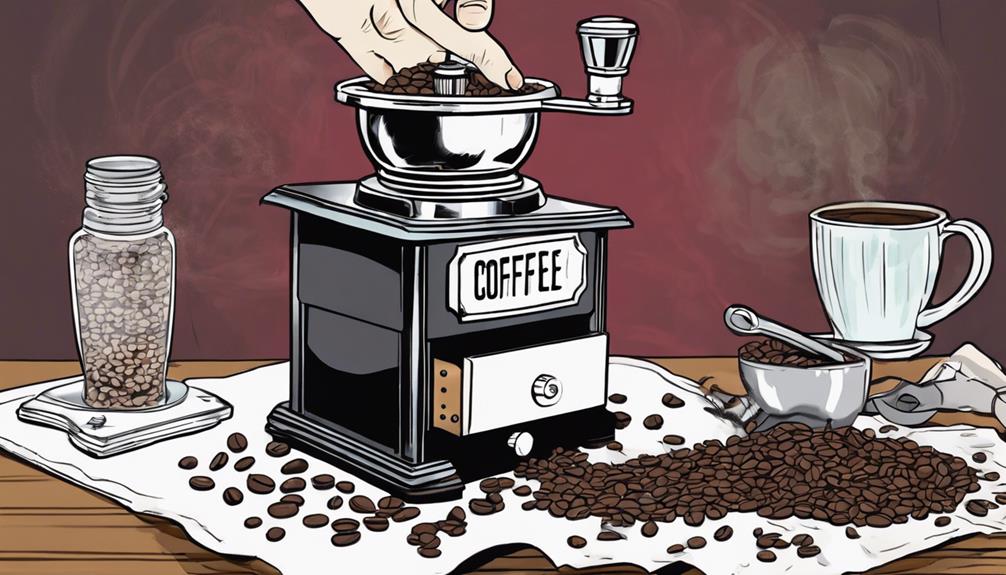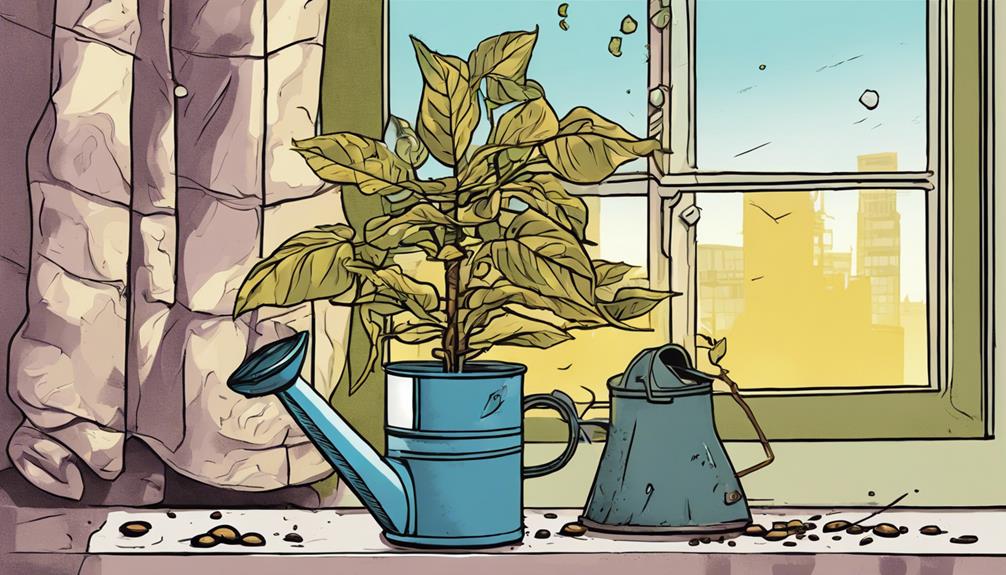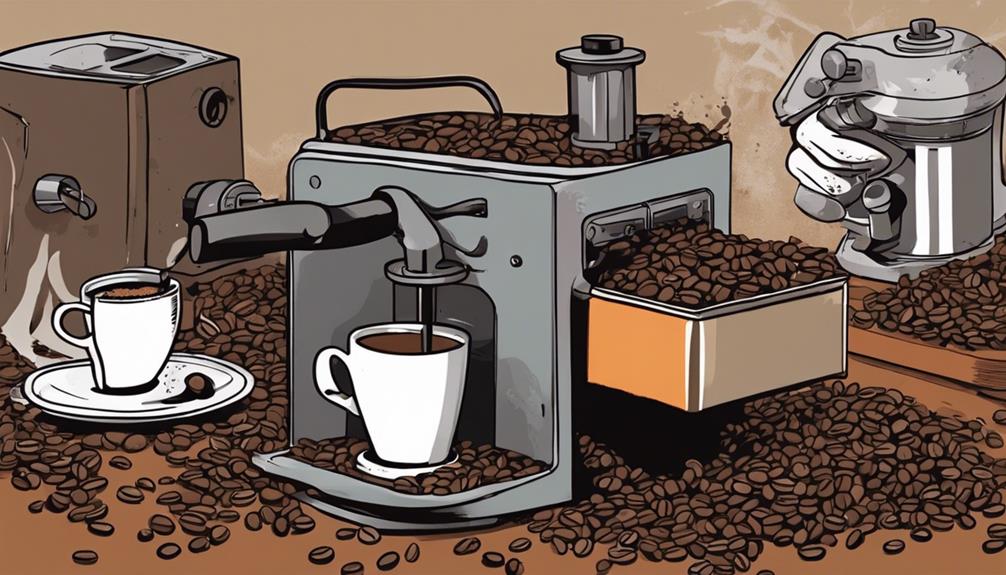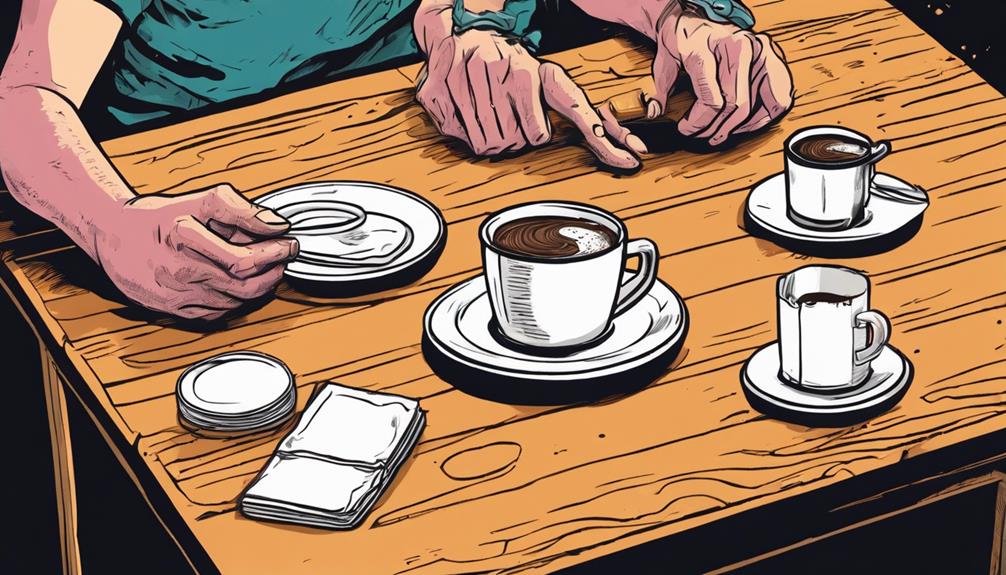To achieve the perfect grind, adjust your coffee grinder to control the flavor extraction precisely. Begin by familiarizing yourself with the manual grinder you own. Access the adjustments by removing the handle and turning the ring. Ensure consistency in your grind by locking in the modifications and verifying with the step dial. Different brewing techniques necessitate specific grind settings, such as coarse for French press and fine for espresso. Mastering these methods will elevate your coffee enjoyment. Interested in learning more about how grind size impacts taste and tips for perfect coffee grinding results?
Key Takeaways
- Use adjustable burr settings for precise grind control.
- Match grind size with brewing methods for optimal flavor.
- Adjust grind size to balance flavor extraction.
- Verify accuracy with step dial for consistency.
- Regularly adjust for factors like bean age and humidity.
Understanding Manual Grinders
To comprehend manual grinders, grasp the importance of adjustable burr settings for precise grind control. Manual coffee grinders provide a hands-on approach to achieving the perfect grind size for your brewing method. With adjustable burr settings, you have the power to finely tune the size of your coffee grounds, ensuring consistency and essential extraction.
Whether you prefer a coarse grind for your French press, a medium grind for pour-over, or a fine grind for espresso, manual grinders offer the flexibility needed to cater to various brewing methods.
Unlike blade grinders, which can produce inconsistent grind sizes due to their blade motion duration, burr grinders guarantee uniformity in particle size. This consistency is crucial for extracting the full flavor potential of your coffee beans.
Importance of Grind Size
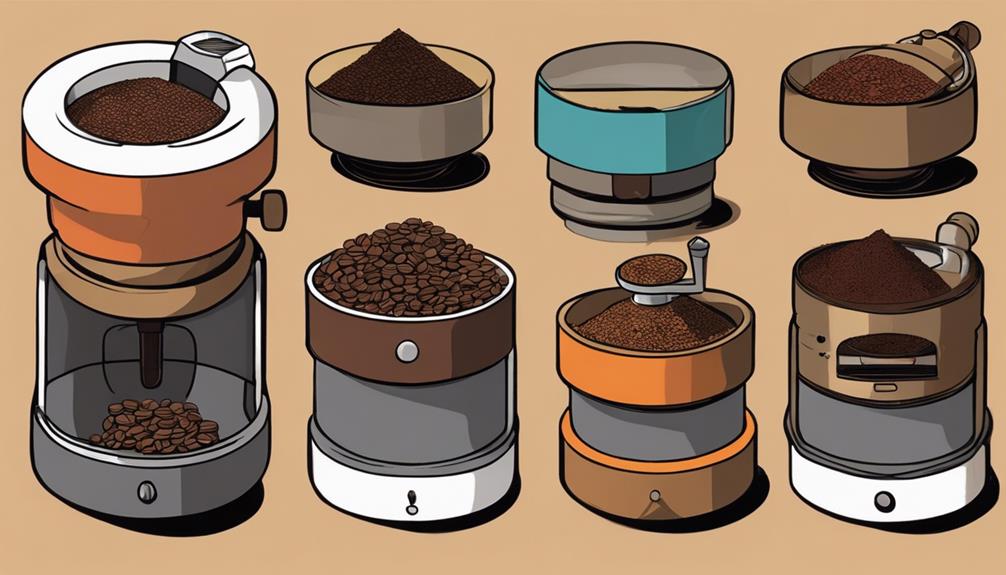
You need to understand that grind size has a significant impact on the flavor extraction of your coffee.
Matching the grind size with your brewing method is essential to achieve the best results.
Balancing the grind size guarantees a consistent and flavorful cup of coffee every time.
Grind Size Impact
Grind size plays a crucial role in determining the flavor extraction of your coffee. The size of the coffee grounds affects the surface area exposed to water during brewing, influencing the extraction process.
Different brewing methods, such as French press or espresso machines, require specific grind sizes to achieve best extraction and balanced flavors. Coarser grinds are suitable for French press, while finer grinds are essential for espresso machines.
It's important to match the grind size with the brewing method to ensure a delicious and well-balanced cup of coffee.
Additionally, when dealing with aging coffee beans, adjustments in grind size may be necessary to maintain consistent flavor extraction.
Brewing Method Match
Selecting the right grind size is crucial for achieving the best flavor extraction when brewing your coffee using different methods such as French press, pour-over, or espresso machines.
To match the grind size with specific brewing methods, adjusting the grinder is essential. Each brewing method requires a different grind setting to ensure consistent taste and best brewing results.
For instance, cold brew, French press, drip coffee, pour-over, espresso, and Turkish coffee each have specific grind settings tailored to their needs.
When adjusting the grind size, consider factors like the age and humidity levels of the coffee beans to achieve an optimal flavor extraction.
Experimenting with grind size adjustments for each brewing method is key to consistently brewing the perfect cup of coffee.
Flavor Extraction Balance
To achieve a balanced flavor extraction in your coffee, understanding the impact of grind size is pivotal. Grind size plays a significant role in controlling the surface area of coffee grounds that come in contact with water during brewing.
Smaller grind sizes result in faster extraction of acids, oils, and flavors, while larger grind sizes necessitate more time for extraction. Adjusting the grind size is essential for striking a harmonious balance between acids, sugars, and bitter compounds in your cup of coffee.
Different brewing methods, such as pour-over, French press, or espresso, require specific grind sizes to optimize flavor extraction. Using the wrong grind size can lead to over-extraction, resulting in a bitter taste, or under-extraction, which leaves the coffee tasting weak.
Adjusting Grind Size Step-By-Step

Begin by removing the handle from your manual coffee grinder to access the adjustment ring for changing the grind size.
Turn the locking ring to make precise modifications until you reach the desired grind size. It's important to secure these adjustments by tightening the locking ring to maintain consistency in your grind.
To verify accuracy, identify the zero-point on the grinder and adjust the step dial accordingly to achieve the preferred grind size.
Following this step-by-step process for changing the grind size will enable you to optimize the performance of your grinder for various brewing methods.
Grind Settings for Brewing Methods

For brewing methods like French press, pour-over, and espresso, adjusting the grind settings is essential to extracting the best flavors from your coffee. Each brewing method requires a specific grind setting to achieve the best taste. For French press and cold brew, a coarse grind is ideal to prevent over-extraction and bitterness.
Medium grinds work well for drip coffee and pour-over methods, balancing flavor extraction and brew time. For espresso, a fine grind is necessary to create the pressure needed for a perfect shot. Understanding these differences and how to adjust the grind size accordingly will greatly enhance your coffee experience.
Tips for Consistent Grind

Achieving a consistent grind size in your coffee beans is vital for best flavor extraction and balance. To ensure an ideal grind every time, start by adjusting your coffee grinder to the appropriate setting for your chosen brewing method.
Experiment with different grind sizes until you find the one that works best for your preferred coffee extraction technique. Consistency is key, so be sure to clean your grinder regularly to prevent any buildup that could affect the grind size.
Proper maintenance, such as cleaning and oiling, is essential for accurate grind settings and peak performance. By following recommended grind settings and taking care of your grinder, you can achieve a consistent grind that leads to a delicious and reliable cup of coffee every time.
Maintenance of Manual Grinder
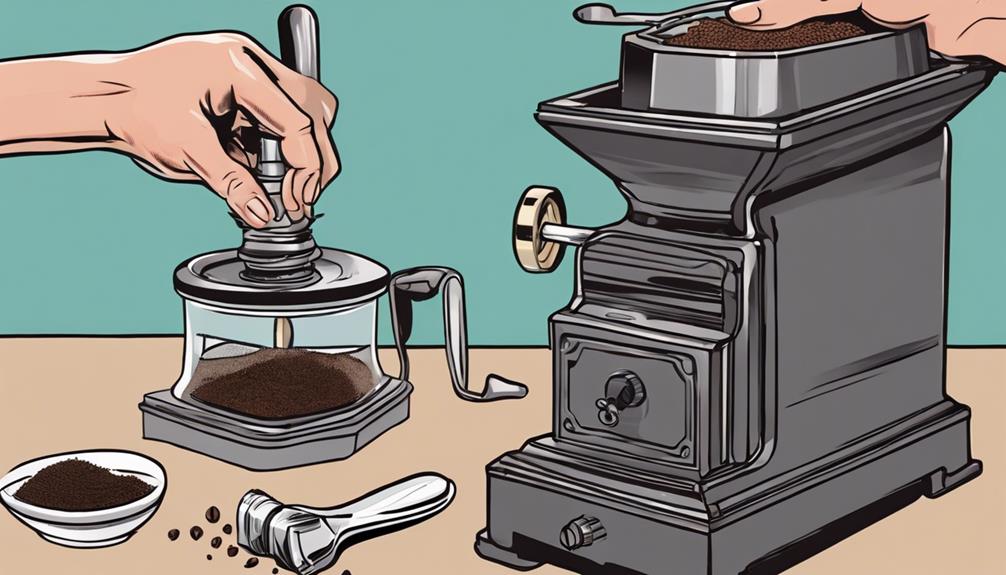
To maintain your manual grinder stays in top shape, it's important to clean the burrs regularly and prevent rust buildup.
Taking the time to disassemble your grinder, use a soft brush for cleaning, and avoiding water contact can prolong its lifespan.
These simple steps are vital for maintaining consistent grind size and enjoying delicious coffee every time.
Cleaning Grinder Burrs
Regularly clean your manual grinder burrs with a soft brush to prevent coffee oils and residue buildup. It's important to maintain your grinder to ensure peak performance and prevent any off-flavors in your coffee. Here's a simple guide to cleaning your grinder burrs effectively:
| Cleaning Steps | Description |
|---|---|
| Disassemble the Grinder | Carefully take apart your grinder to access the burrs for thorough cleaning. |
| Brush the Burrs | Gently brush the burrs with a soft brush to remove any trapped coffee oils and residue. |
| Avoid Using Water | Refrain from using water to clean the burrs as it can lead to rusting and affect performance. |
| Reassemble the Grinder | Once cleaned, reassemble the grinder ensuring everything is securely put back together. |
Regularly cleaning and maintaining your grinder burrs will not only keep your grind size consistent but also promote durability and enhance the overall flavor of your coffee.
Preventing Rust Buildup
To maintain a manual grinder and prevent rust buildup, make certain that water isn't used during cleaning as it can lead to corrosion and affect the grinder's performance. Instead, utilize a soft brush to clean grinder burrs and eliminate coffee residue, effectively averting rust formation.
By incorporating regular cleaning and proper maintenance practices into your routine, you can prolong the lifespan and optimize the performance of your manual grinder. Remember to keep the manual grinder dry and store it in a cool, dry place to prevent rust from developing.
Promptly addressing any potential rust issues in manual grinders is crucial to maintaining consistent grind quality and preventing contamination. By following these steps and keeping your manual grinder well-maintained, you can ensure that it continues to operate smoothly and efficiently for a long time.
Coffee Grinding Techniques
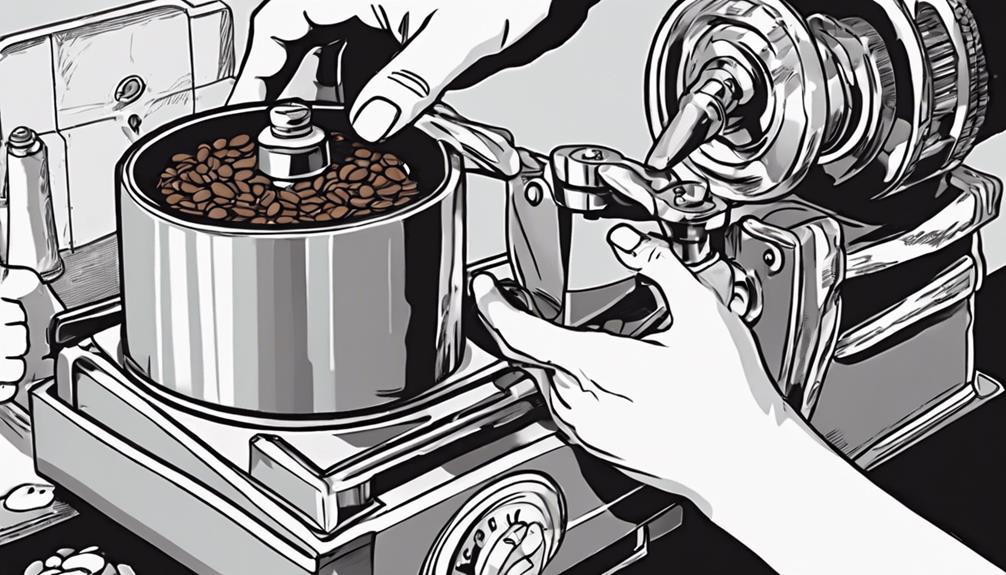
Adjusting the grind size of your coffee beans is essential in controlling the flavor extraction process. The size of the grounds plays a pivotal role in how quickly flavors are released during brewing.
Smaller grounds result in a swifter extraction of acids, oils, and sugars, whereas larger grounds require more time to extract flavors, affecting the taste of your coffee.
Different brewing methods like the French press and pour-over each require specific grind sizes to achieve best flavor extraction.
For instance, a coarse grind is ideal for French press to prevent over-extraction, while a medium grind works best for pour-over to balance extraction time and flavor profile.
Reasons for Grinder Adjustments

Coffee grinder adjustments are necessary due to various factors that can impact the extraction process and flavor of your coffee. As coffee beans age, their gas content decreases, affecting the extraction speed and necessitating adjustments to the grinder. Fresh beans with higher gas levels may require a finer grind setting to achieve best possible extraction, while factors like humidity and weather fluctuations can influence the grind settings, leading to the need for regular adjustments to maintain consistency in flavor.
To summarize the reasons for grinder adjustments, refer to the table below:
| Reasons for Grinder Adjustments | Impact on Coffee Grinding |
|---|---|
| Coffee beans age | Gas content decreases, affecting extraction speed |
| Fresh beans with higher gas levels | Require a finer grind setting for best possible extraction |
| Humidity fluctuations | Necessitate a coarser grind to maintain consistency |
| Weather changes | Require regular adjustments to achieve desired extraction |
Frequently Asked Questions
How Do You Adjust the Grind on a Coffee Grinder?
To adjust the grind on a coffee grinder, turn the adjustment ring for burr grinders or select grind size settings for blade grinders. Achieve the desired coarseness or fineness for your brewing method to enjoy the perfect cup of coffee. If you are using an antique coffee grinder, you may need to adjust the grind manually by loosening or tightening the grind screw. It may take some trial and error to find the perfect grind size, but once you do, you’ll be able to enjoy a delicious cup of coffee with a rich and balanced flavor. Don’t be afraid to experiment with adjusting antique coffee grinders to achieve the perfect grind for your favorite brewing method.
What Is the Perfect Grind Setting?
To find the perfect grind setting, you must dance to the tune of your brewing method. Coarse for French press, fine for espresso. Experiment, taste, adjust. Let your coffee sing with balanced flavors – a symphony in every cup.
How to Get Coffee Grind Size Right?
To get the coffee grind size right, start by experimenting with different settings based on your brewing method. Adjust the grinder until you achieve the desired texture. Consistency is key for ideal flavor extraction in your coffee.
How Do You Get an Even Grind With a Coffee Grinder?
To get an even grind with a coffee grinder, adjust settings for consistent particle size. Use a manual grinder with precise adjustments for evenness. Experiment with grind sizes, clean your grinder regularly, and make small adjustments for a flavorful cup.
Conclusion
Now that you know how to adjust your coffee grinder like a pro, you'll be able to grind perfectly every time.
Remember, practice makes perfect, so don't be afraid to experiment with different grind sizes to find what works best for you.
As they say, the proof is in the pudding – or in this case, the coffee!
Keep grinding away and enjoy your deliciously brewed cup of joe.
